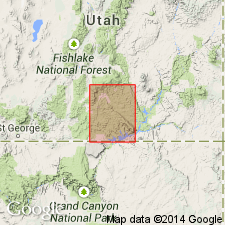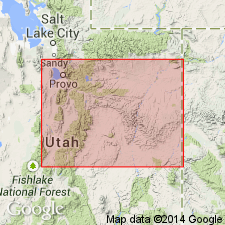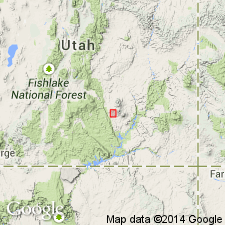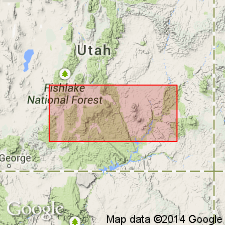
- Usage in publication:
-
- Blue Gate shale
- Modifications:
-
- Original reference
- Dominant lithology:
-
- Shale
- AAPG geologic province:
-
- Paradox basin
Summary:
Pg. 4+. Blue Gate shale. Blue black argillaceous shale weathering to a fine gray clay. Thickness 1,000 feet. Underlies Blue Gate sandstone and overlies Tununk sandstone in Blue Gate Plateau. Present in Henry Mountains region, [Wayne and Garfield Counties], central southern Utah. Fossiliferous (mollusks INOCERAMUS DEFORMIS and I. PROBLEMATICUS). Age is Late Cretaceous.
[GNC remark (ca. 1938, US geologic names lexicon, USGS Bull. 896, p. 219): †Blue Gate shale in Mancos shale. Is a part of Mancos shale, but name conflicts with Blue Gate sandstone, the adopted name.]
Source: US geologic names lexicon (USGS Bull. 896, p. 219).

- Usage in publication:
-
- Blue Gate Member*
- Modifications:
-
- Revised
- Areal extent
- AAPG geologic province:
-
- Paradox basin
Summary:
Is the middle member (of five) of the Upper Cretaceous Mancos Shale mapped only in northeast part of quad, in the Henry basin, east of Waterpocket fold, Garfield Co, UT in the Paradox basin. Mapped limit represents the southwest limit for the member. Term "Shale" removed from geologic name. Is 1,200 to 1,500 ft thick. Overlies Ferron Sandstone Member; underlies Emery Sandstone Member, both of Mancos. Its equivalent to southwest on Kaiparowits Plateau is the upper lower and lower upper parts of Straight Cliffs Formation.
Source: GNU records (USGS DDS-6; Denver GNULEX).

- Usage in publication:
-
- Blue Gate Member*
- Modifications:
-
- Age modified
- AAPG geologic province:
-
- Paradox basin
Summary:
Lower part assigned to the late Turonian, Coniacian to middle Santonian; upper part assigned to the late Santonian in the Paradox basin.
Source: GNU records (USGS DDS-6; Denver GNULEX).

- Usage in publication:
-
- Blue Gate Shale Member
- Modifications:
-
- Overview
- AAPG geologic province:
-
- Paradox basin
Summary:
Is middle member (of five members) of Mancos Shale in Henry Mountains and in Paradox basin. Alternate spelling as Bluegate also used in this report. Underlies a newly named unit, Muley Canyon Sandstone Member. Is of Late Cretaceous, or of early Campanian age. Correlates with Drip Tank Member of Straight Cliffs Formation and the lower member of Wahweap Formation of Kaiparowits plateau. Correlates with Starpoint [sic] Sandstone and lower part of Blackhawk Formation of Wasatch Plateau. Is of shallow marine (base), prodelta, and transition (top) origin.
Source: GNU records (USGS DDS-6; Denver GNULEX).

- Usage in publication:
-
- Blue Gate Shale Member
- Modifications:
-
- Revised
- AAPG geologic province:
-
- Paradox basin
Summary:
Considered to be the uppermost member of three members of Mancos Shale in south-central UT, Garfield Co in the Paradox basin. The overlying Muley Canyon, formerly considered a member of the Mancos, is raised to formation rank and removed from the Mancos. Overlies Ferron Sandstone Member of Mancos. Assigned to the Santonian. Stratigraphic tables.
Source: GNU records (USGS DDS-6; Denver GNULEX).
For more information, please contact Nancy Stamm, Geologic Names Committee Secretary.
Asterisk (*) indicates published by U.S. Geological Survey authors.
"No current usage" (†) implies that a name has been abandoned or has fallen into disuse. Former usage and, if known, replacement name given in parentheses ( ).
Slash (/) indicates name conflicts with nomenclatural guidelines (CSN, 1933; ACSN, 1961, 1970; NACSN, 1983, 2005, 2021). May be explained within brackets ([ ]).

